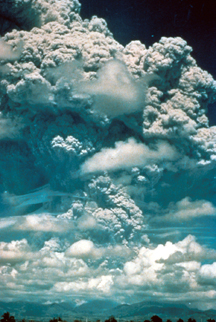 Although
the rate of sea-level rise has accelerated over the past half-century with warming
oceans and melting polar and mountain glaciers, about 10 years ago, the rate
of sea-level rise surprisingly halted. Then, over the following decade, it started
to increase again. Researchers have found that the likely culprit for this pause
and acceleration was the 1991 eruption of Mount Pinatubo in the Philippines.
Although
the rate of sea-level rise has accelerated over the past half-century with warming
oceans and melting polar and mountain glaciers, about 10 years ago, the rate
of sea-level rise surprisingly halted. Then, over the following decade, it started
to increase again. Researchers have found that the likely culprit for this pause
and acceleration was the 1991 eruption of Mount Pinatubo in the Philippines.
In June 1991, Mount Pinatubo, viewed here from Clark Air Force Base, erupted, affecting the atmosphere and oceans worldwide, including slowing global sea-level rise, as researchers recently determined. Image by Karin Jackson, U.S. Air Force; courtesy of USGS.
Pinatubo exploded on June 15, 1991, pumping 20 million tons of sulfur dioxide into the atmosphere, with dramatic atmospheric effects, including global cooling and changes to ozone. A team of Australian researchers, led by John Church of CSIRO, in Hobart, Tasmania, used global climate models that both incorporate and leave out volcanic activity, in an attempt to see if they could isolate the volcano’s effects on sea-level rise, which on average increases almost 2 millimeters a year. The models showed that Pinatubo could account for a decrease of about 6 millimeters of sea level in the first year after its eruption, the team reported in the Nov. 3 Nature.
The sulfur dioxide the volcano spewed out reflected sunlight, decreasing the amount of energy reaching the oceans. Subsequently, the oceans, which hold onto heat for much longer than air does and also take longer to warm up, took a few years to recover from Pinatubo’s cooling effects, the researchers concluded, before returning to previous rates of sea-level increases, due to ongoing warming.
The results led Church and his colleagues to conclude that very large volcanic eruptions affect not only global climate, but also how sea level changes on decadal scales, which could explain previously observed fluctuations in sea-level records. Similar effects were present with the large eruptions at Mount Agung in Indonesia in 1963 and El Chichón in Mexico in 1982, though data from those events are not as good as Pinatubo observations.
Although all global climate models incorporate volcanic impacts on climate, including on atmospheric and oceanic temperature effects, their “effect on sea level hadn’t been isolated before,” says Brian Soden of the University of Miami Rosenstiel School of Marine and Atmospheric Science. And Alan Robock of Rutgers University in New Brunswick, N.J., says that he found the new results “very interesting” if somewhat expected: Cooling the oceans causes them to contract. Still, the researchers “are the first ones I know of to quantify this effect” from a volcano.
Robock says that such large volcanic eruptions provide another way to explore climate. “It’s a strong shock to the system that goes away pretty quickly,” he says, allowing modelers to compare their results with actual observable data.

